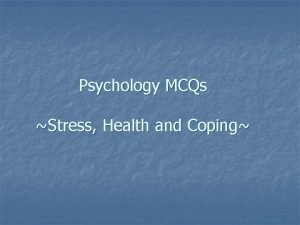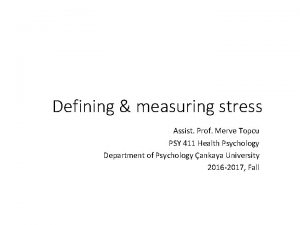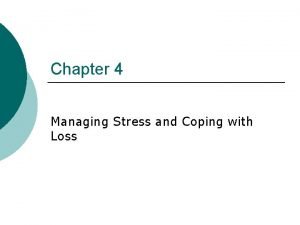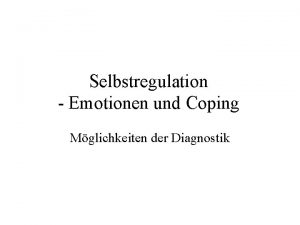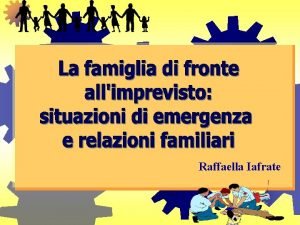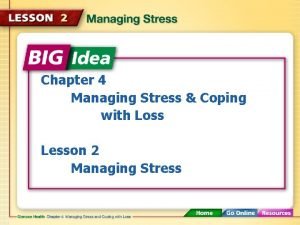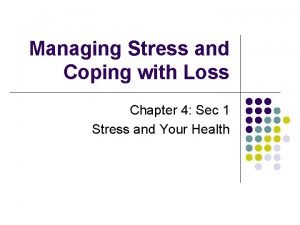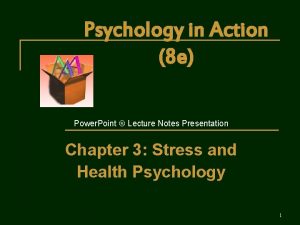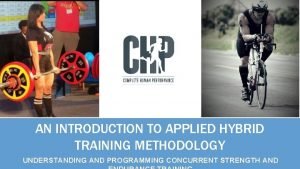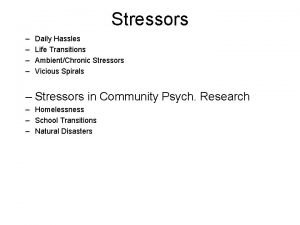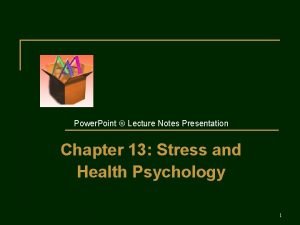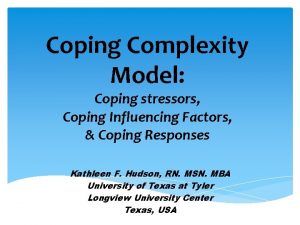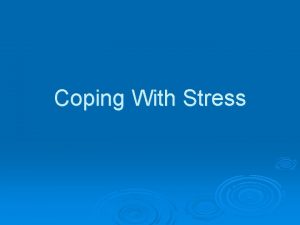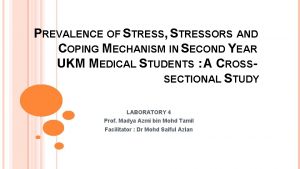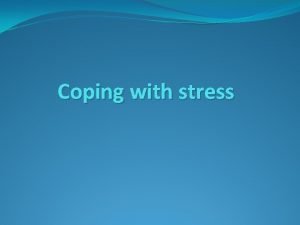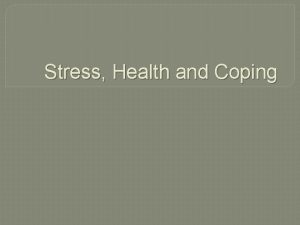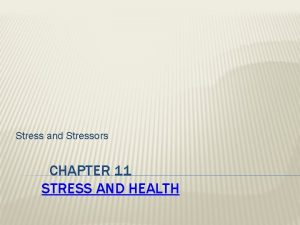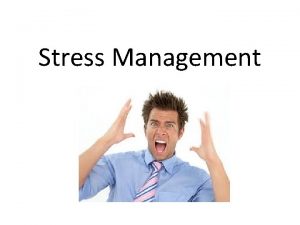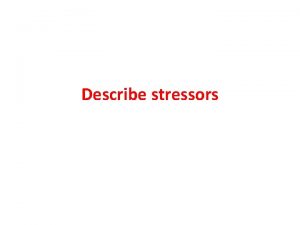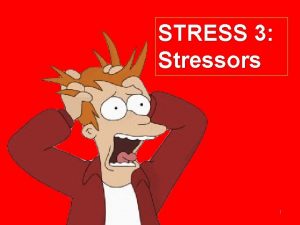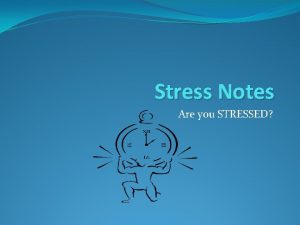Coping with Stress 1 2 Outline two stressors



















- Slides: 19

Coping with Stress 1. 2. Outline two stressors and evaluate one strategy for coping with stress Outline the procedures used in TWO strategies that humans can use to cope with stress. Compare the effectiveness of these strategies.

Coping Strategies • Folkman & Lazarus – Problem-Focused, Emotion Focused • Social Support – Emotional, informational, practical support • Kabat – Mindfulness-Based Stress Reduction (MBSR)

Folkman & Lazarus • People’s appraisal of their own situation and their ability to cope with it impact coping strategy • Problem-Focused – Best in situations that are perceived as controllable • Emotion-Focused – Best in situations that are perceived as uncontrollable

Social Support • Related to emotionfocused coping – Buffer against physiological and psychological stress response • Examples – In-group, partner, friends, relatives • Perception of support is stronger than actual social support

Types of Social Support • Emotion support – Listening, empathizing – Verbal, non-verbal communication of caring • Informational support – Advice and information to help a person • Practical support – Tangible assistance • Transportation, financial, help with chores

Neuling and Winefield, 1988 • AIM: role of social support in female breast cancer patients • Method: Longitudinal study – Interviews – Survey: rate frequency of social support (all three types) • Results – Family support was most frequent – Wished for more informational support from doctors – Not cause and effect: no evidence it actually impacted course of cancer • Implications – Social support can be beneficial to adjusting to the stress of cancer

Discussion • Do you think individuals should be able to receive a prescription to carry their dog/cat everywhere to help them cope with stress and anxiety?

Allen et al. . 1999 • Aim: investigate whether owning a pet reduces stress • Participants: Male and Females who live alone and suffered from mental stress • Method: – IV: Dog or Cat added to the treatment for high stress – DV: blood pressure and heart rate • Results: – More stable with a pet • Especially with a limited social network

Evaluation of Social Support • Humans and pets can be social support • More common among women • Perception of support is important • Cultural norms – Seek and use advice and emotional support • Taylor et al, 2007 – Asians benefited less from social support

MBSR • Mindfulness-Based Stress Reduction • Connected to Lazarus’ theory of coping – Emotion-focused coping • Deals with the physical and emotional aspects of stress – Gradual relaxation – Problem-focused coping • Learn new skills to combat stress • Goal – Awareness of the moment to avoid negative thinking

Shapiro et al. , 1998 • AIM: impact of MBSR to control exam stress • Method: Experiment – 2 groups: those in an MBSR training course and those on the wait list • Procedure: – Step one: initial measure of stress and level of empathy (no difference between groups) – Step two: measure stress at the end of the term • Results – MBSR class had less stress than at the beginning of the term • Course taught them to cope • Limitation – Not applicable to everyone, you need to be willing

Grossman et al. , 2003 • Method: Meta Analysis of 20 controlled studies on MBSR • Results – MBSR can be helpful to a wide range of people • Clinical and nonclinical problems

Evaluation of MBSR • Strategy is costeffective and timeefficient – Supports adaptation and adjustment to stress • Gaining strength – Increase in research studies • Research is promising for cancer patients – More research needed

Stress Inoculation Training (SIT) • Cognitive Approach: change thought processes (Meichenbaum) – Training comes before stressful event – Therapy • Three Phases – Conceptualization phase – Skills acquisition and rehearsal phase – Application and follow through phase

Three Phases 1. Conceptualization phase – Socratic approach – Stress is a problem to be solved – Re-conceptualization: plan to combat stress 2. Skills acquisition and rehearsal phase 1. skills for coping are offered and practiced 1. Relaxation, social support, problem solving 3. Application and follow through phase 1. Imagine stressful events and apply skills 1. Imagery and role playing *** Practice***

Evaluation of SIT • Accepts that stress is unavoidable • Tailored therapy to the individual • Emphasizes emotional and cognitive awareness • Based cooperation (client & therapist) • Individual responses to stress vary • Lots of time and money • High level of commitment and motivation • Cultural differences: – North America promote empowerment – Not all cultures encourage discussion of feelings and private thoughts

Yoga • Holistic approach to stress reduction – Incorporates physical, cognitive and spiritual concepts – Promote awareness • Types – Asana: physical flexibility and meditation – Pranayama: energy control through breathing (breath meditation)

Hartfiel et al. , 2010 • Hypothesis: Yoga increases physical and emotional well-being • Method: experiment – IV: dru yoga (breathing, relaxation, meditation)for 6 weeks – DV: psychological tests measuring mood and wellbeing • Results: – Increase in clear-mindedness, composure, energy and confidence

Evaluation • Provides physical and emotional support – Physical exercise – Social outlet – Education about the body • May be limited – Stress is usually specific to the person, yoga isn’t • Must internalize the teaching – Cultural and personal limitations
 Chapter 4 managing stress and coping with loss
Chapter 4 managing stress and coping with loss Stress strain coping support model
Stress strain coping support model Stress management mcqs
Stress management mcqs Stress appraisal and coping
Stress appraisal and coping Coping strategies for exam stress
Coping strategies for exam stress Chapter 4 managing stress and coping with loss
Chapter 4 managing stress and coping with loss Stress strain coping support model
Stress strain coping support model Family stress and coping
Family stress and coping Chapter 4 lesson 2 managing stress answer key
Chapter 4 lesson 2 managing stress answer key Chapter 4 managing stress and coping with loss
Chapter 4 managing stress and coping with loss Problem focused coping examples
Problem focused coping examples Walter cannon observed that a variety of stressors trigger
Walter cannon observed that a variety of stressors trigger Consolidation of stressors
Consolidation of stressors Types of stressors life orientation
Types of stressors life orientation Stressors
Stressors Life stressors
Life stressors Walter cannon observed that a variety of stressors trigger
Walter cannon observed that a variety of stressors trigger Engineering vs true stress strain curve
Engineering vs true stress strain curve Axial normal stress
Axial normal stress Chapter 10 stress responses and stress management
Chapter 10 stress responses and stress management


